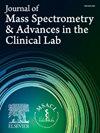LC-MS/MS法测定人血浆中粘菌素和粘菌素甲磺酸的含量及其在稳定性研究和治疗药物监测中的应用
IF 3.4
4区 医学
Q2 MEDICAL LABORATORY TECHNOLOGY
Journal of Mass Spectrometry and Advances in the Clinical Lab
Pub Date : 2025-06-01
DOI:10.1016/j.jmsacl.2025.05.001
引用次数: 0
摘要
粘菌素是抵抗多重耐药革兰氏阴性细菌感染的最后一道防线,在临床实践中通常作为其前药粘菌素甲磺酸(CMS)给药。然而,由于其显著的肾毒性和狭窄的治疗窗口,治疗药物监测(TDM)是必不可少的。目的建立hplc -MS/MS定量测定人血浆中粘菌素和CMS的最佳方法,并将其应用于稳定性研究和TDM。方法采用固相萃取柱从血浆中提取黏菌素A、黏菌素B和内标(IS、多粘菌素B2)。样品采用Welch Ultimate LP-C18色谱柱进行分离,用1.0%甲酸的水和乙腈梯度洗脱5分钟。通过比较酸水解和非酸水解血浆中粘菌素的总量,得出CMS浓度。结果黏菌素A和黏菌素B在0.1 ~ 10.0 μg/mL范围内呈良好的线性关系(R2 >;0.995)具有可接受的特异性、准确度(90.97% ~ 114.65%)、精密度(RSD <;15%)、矩阵效应(RSD <;回收率为91.93% ~ 100.93%。5种常用的临床输液液中CMS在室温下保存8 h或在4℃下保存24 h时均保持稳定。CMS的全血和血浆样品在室温下易降解,但在冰上保持稳定。准确测定3例危重患者血浆粘菌素和CMS浓度。结论该方法稳健、简便,为粘菌素和CMS在危重患者TDM中的应用提供了潜在的可行性。本文章由计算机程序翻译,如有差异,请以英文原文为准。
Development of an LC-MS/MS method for quantification of colistin and colistin methanesulfonate in human plasma and its application to stability studies and therapeutic drug monitoring
Introduction
Colistin serves as the last line of defense against multidrug-resistant Gram-negative bacterial infections and is commonly administered in clinical practice as its prodrug, colistin methanesulfonate (CMS). However, due to its notable nephrotoxicity and narrow therapeutic window, therapeutic drug monitoring (TDM) is essential.
Objectives
To develop an optimal LC-MS/MS method for the quantification of colistin and CMS in human plasma and to apply it to stability studies and TDM.
Methods
Colistin A, colistin B, and internal standard (IS, polymyxin B2) were extracted from plasma using solid phase extraction columns. Sample separation was performed using a Welch Ultimate LP-C18 column with a 5-minute gradient elution consisting of water and acetonitrile, both supplied with 1.0% formic acid. The CMS concentration was obtained by comparing the total amount of colistin in acid-hydrolyzed and non-acid-hydrolyzed plasma.
Results
Colistin A and colistin B showed excellent linearity in the concentration range of 0.1–10.0 μg/mL (R2 > 0.995) with acceptable specificity, accuracy (90.97 %–114.65 %), precision (RSD < 15 %), matrix effect (RSD < 15 %), and recovery (91.93 %–100.93 %). CMS in five commonly used clinical infusion solutions was stable when stored at room temperature for 8 h or at 4 °C for 24 h. The whole blood and plasma samples of CMS are susceptible to degradation at room temperature but are stable on ice. Plasma concentrations of colistin and CMS were accurately determined in three critically ill patients.
Conclusion
The method we have developed is robust and streamlined, and has successfully demonstrated the potential feasibility for future TDM applications of colistin and CMS in critically ill patients.
求助全文
通过发布文献求助,成功后即可免费获取论文全文。
去求助
来源期刊

Journal of Mass Spectrometry and Advances in the Clinical Lab
Health Professions-Medical Laboratory Technology
CiteScore
4.30
自引率
18.20%
发文量
41
审稿时长
81 days
 求助内容:
求助内容: 应助结果提醒方式:
应助结果提醒方式:


